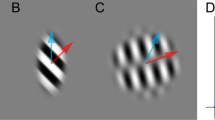Abstract
Two experiments examined the discrimination by pigeons of relative motion using computer-generated video stimuli. Using a go/no-go procedure, pigeons were tested with video stimuli in which the camera’s perspective went either "around" or "through" an approaching object in a semi-realistic context. Experiment 1 found that pigeons could learn this discrimination and transfer it to videos composed from novel objects. Experiment 2 found that the order of the video’s frames was critical to the discrimination of the videos. We hypothesize that the pigeons perceived a three-dimensional representation of the objects and the camera’s relative motion and used this as the primary basis for discrimination. It is proposed that the pigeons might be able to form generalized natural categories for the different kinds of motions portrayed in the videos.
Similar content being viewed by others
Author information
Authors and Affiliations
Additional information
Accepted after revision: 23 March 2001
Electronic Publication
Rights and permissions
About this article
Cite this article
Cook, R.G., Shaw, R. & Blaisdell, A.P. Dynamic object perception by pigeons: discrimination of action in video presentations. Anim.Cogn. 4, 137–146 (2001). https://doi.org/10.1007/s100710100097
Received:
Published:
Issue Date:
DOI: https://doi.org/10.1007/s100710100097




